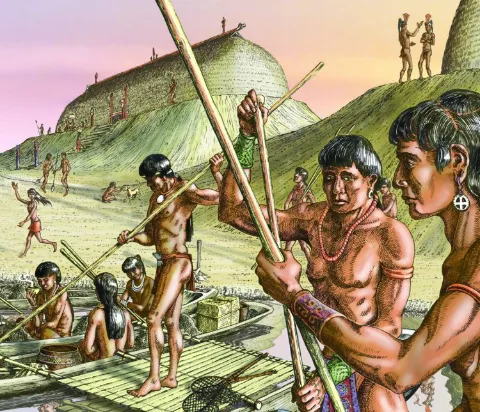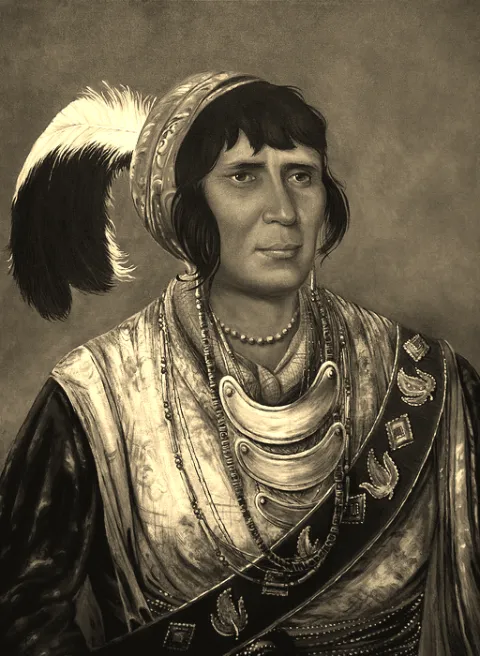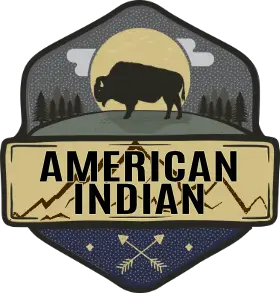The Long Journey: A History of Florida’s First Peoples
For untold generations before Ponce de León landed on Florida’s shores, a mosaic of vibrant native cultures flourished across its varied landscapes – from the cypress swamps of the north to the sun-kissed keys of the south.
Sophisticated tribes like the Timucua and fierce warriors like the Calusa navigated its waterways and harvested its bounties, leaving behind relics that intrigue us still.
Keepers of the Waterways
The Timucua held sway over much of northern Florida. Master dugout canoe builders, they skillfully navigated the winding waterways and dense thickets of their domain.
Fish and shellfish nourished their bodies while elaborate ceremonies fed their souls. Their massive shell mounds still stand as monuments to a complex culture.
Down south, the fierce Calusa reigned supreme on the peninsula’s sunny coasts.
These “Shell People” spread their influence from Tampa Bay to the Ten Thousand Islands, dominating neighboring tribes through warfare when trade and tributes failed to suffice.
Their watery capital at Mound Key was surrounded by a bustling canal system, reflecting a society at its zenith.
Calusa Legacy

On the shell-strewn shores of Mound Key, an afternoon breeze carries the cries of circling gulls over the royal city of Calos. This island citadel once stood as the capital of the mighty Calusa, who ruled Southwest Florida centuries before Columbus sailed.
At its height, the domain of these “fierce people” stretched from Tampa Bay down to the Ten Thousand Islands, with trade and tribute enriching the Calusa treasury. Their formidable war canoes patroled the waters of Estero Bay, while tributaries and allies submitted to their authority.
But the winds of fortune shifted after Ponce de León’s arrival in 1513 heralded European contact. By the mid-1700s, their numbers ravaged by disease and warfare, the Calusa had faded from history’s stage.
Yet echoes of their legacy still resonate. In the massive shell mounds and canal systems of Mound Key, archaeologists uncover clues to the complex capital that once thrived here. And strands of their language may persist in modern Seminole and Cuban speech. Though conquered and converted by Spain, the Calusa spirit endures along Florida’s gulf coast – fierce and unconquerable as the tides themselves.
Lords of the Hunt
But Florida’s indigenous peoples trace their ancestry back to even earlier times. Some 12,000 years ago, nomadic Paleoindian hunters stalked mastodons, giant ground sloths and other massive beasts across an arid landscape twice the size it is today.
These pioneers survived by their wits, gathering wild fruits and roots as glacial ice locked up sea waters and left Florida’s wetlands parched.
After the great ice sheets melted and temperatures warmed, the people adapted to transformed ecosystems stocked with fish and shellfish. Around 3000 BCE, permanent villages with shell mounds and plazas emerged near Florida’s newly flourished wetlands and lakes.
A wide array of regional cultures thrived over thousands of years – their traditions still echo in the sun-dappled marshes and palm hammocks of this land today.
For untold generations, native peoples harvested nature’s bounty from the land and sea, leaving behind vestiges of their lives in mounds, middens and artifacts that intrigue and humble us.
Sword and Cross
In 1513, Spanish fortune hunter Juan Ponce de León arrived on these shores seeking mythical treasures, but found something far more precious – an exotic land inhabited by tens of thousands of Native Americans.
Conflict quickly erupted between the encroaching Europeans and suspicious natives defending their homelands.
The Mission System
In 1565, Spain established the colony of St. Augustine and began constructing an extensive mission system to spread Christianity among the indigenous tribes. While some converted and assimilated into colonial society through intermarriage, many others perished from introduced diseases like smallpox and measles against which they had no immunity.
By 1703, only 12,000 remained of the hundreds of thousands of natives living in Spanish Florida a century earlier. But epidemics and guerrilla warfare with the English and their native allies were not the only perils faced by tribes like the Timucua, Calusa and Apalachee in the Spanish colonial era.
Neither Sword nor Cross
The mission system extracted backbreaking labor from Native Americans in support of St. Augustine and kept resistant tribes under control. Thousands of Apalachees joined the Timucua in being marched off into servitude, their traditional beliefs and customs suppressed under Spanish rule.
Those who survived and evaded capture had retreated deep into Florida’s swamps and hidden coastal enclaves by the 1700s.
The Calusa faded from history, but other tribes took refuge in the wilds of an increasingly tamed land, keeping hope alive for a new day of freedom and self-determination.
Seminole Dawn
As Spanish power waned in the 1700s, fledgling new tribes emerged among the wetland hammocks and pine flatwoods of northern Florida.
Mostly descendants of Lower Creek Indians from Georgia and runaway African-American slaves, these fiercely independent bands came to be known collectively as “Seminoles,” a name meaning “wild people” or “runaways.”
Against the Tide
After the United States acquired Florida from Spain in 1819, tensions escalated as American settlers moved onto traditional Seminole lands.
Seeking to placate demands to remove all Native Americans west of the Mississippi, the U.S. government attempted to force the Seminoles’ relocation through coercive treaties and military action.
Chief Osceola

On a humid Florida morning in October 1837, the great Seminole warrior Osceola sat confined in the cramped prison at Fort Marion near St. Augustine.
Just months earlier, this battle-hardened leader of the Seminole resistance had been free to roam the dense hammocks and swamps of his ancestral homelands. But through deception and dishonesty, the Americans had captured Osceola under a false flag of truce.
With his arrest, the swaggering U.S. generals believed they had broken the Seminoles’ unconquerable spirit and finally ended their audacious rebellion. But they underestimated Osceola and his unrelenting band of Seminole Braves.
Though weakened by malaria and disheartened by betrayal, the half-British, half-Creek Osceola remained defiant till the end. His steely gaze and ramrod straight back showed that here stood a proud warrior who bowed to no man.
Soon after arriving at Fort Marion, Osceola would succumb to illness and die, far from the Florida scrub he loved. But the fight he began would live on even longer than the embattled leader himself.
Though Osceola perished in captivity, his people’s resistance continued. The unconquered Seminoles fought on, confounding the Americans for eight more long years.
Their grit and tenacity was Osceola’s lasting legacy, cementing his legend as the courageous chief who dared challenge a rising nation’s quest for conquest.
Unconquered People
For their stubborn resistance, the Seminoles found themselves engulfed in three major wars spanning from 1817 to 1858. Using guerrilla tactics perfected in Florida’s swamps, the vastly outgunned Seminoles repeatedly confounded and embarrassed the U.S. Army.
Though reduced in number, hundreds evaded capture in remote outposts like the sprawling Everglades. Their unconquered spirit endured when guns and money failed to suffice.
Through perseverance and sheer grit, the Seminoles wrote one of history’s most dramatic stories of underdogs defying the odds and charting their own destiny.
The Long Road
Against the odds, the Seminole people survived wars of extermination and ethnic cleansing policies to enter the 20th century with their identity and heritage intact.
In 1957, the tribe organized as the official Seminole Tribe of Florida, gaining federal recognition. The Miccosukee Tribe, composed of Seminoles who had evaded earlier forced relocations, soon followed suit.
The Past Informs the Future
Today, these tribes operate prosperous casino resorts and exert sovereignty over their reservation lands while preserving ancient traditions.
Across Florida, Native American cultural centers educate visitors on the state’s indigenous history and living cultures. The identities of 36,000 Native American Floridians testify to the resilience of those who walked this land first.
Though much has changed in 500 years, Florida remains Native American territory at heart – its very name derived from the Calusa town of Calla-osha.
As modern tribes confront challenges like climate change, their ancestors’ wisdom offers guidance. By honoring the past while looking to the future, Florida’s native peoples keep their culture’s fire burning bright.
The identities and values of Florida’s original inhabitants have withstood conquistadors, missionaries, armies and developers. Their bold legacy sets the course for new generations underway on an ancient journey.
